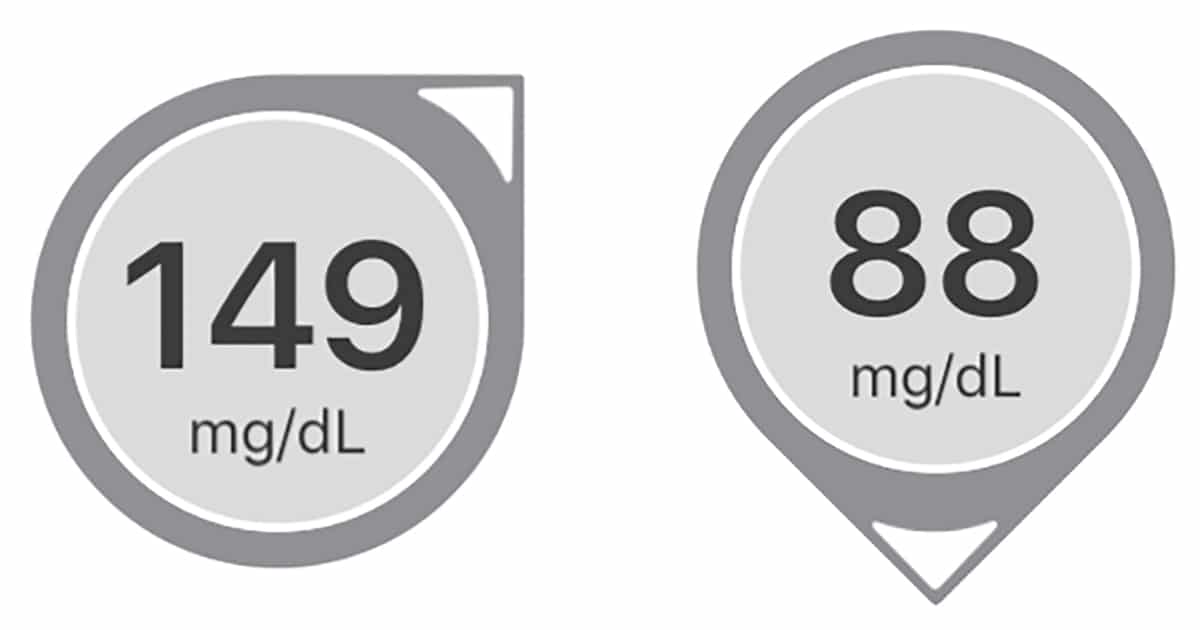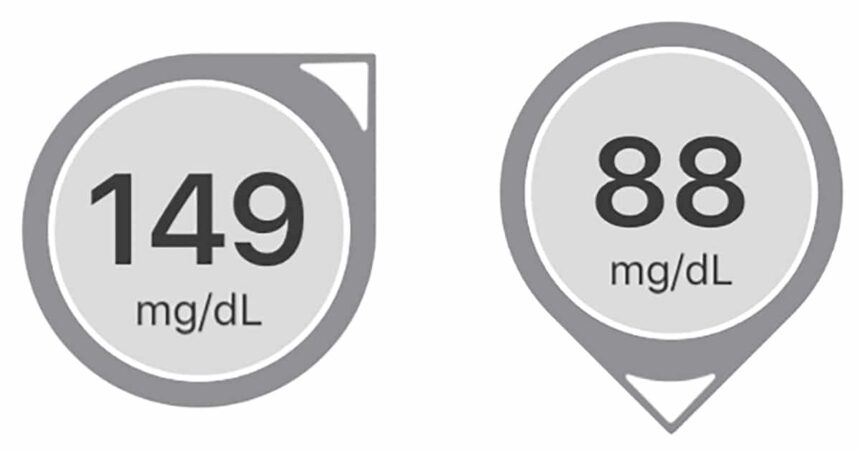In case you are utilizing CGM (Steady Glucose Monitor), you already know what number of game-changers this know-how could make in terms of diabetes administration.
Getting perception into our historical past of blood sugar, what our blood sugar is for now, the place it’s, and the place it’s, brings peace of thoughts, making managing diabetes a lot simpler, Safer.
However even in the event you love your CGM, do you employ trending arrows for insulin changes? If not, you’re really lacking out on the chances of know-how utterly.
Listening to the arrows in CGM developments permits for extra aggressive and knowledgeable selections relating to insulin dose changes.
The data on this put up is restricted to the Dexcom CGM system. Different CGM techniques additionally use pattern arrows, however please observe that in case you are utilizing different techniques, we are going to make the most of the data right here.
In case you open the Dexcom app or have a look at the receiver, you will note that you will note your present blood sugar stage and what is going to occur in half-hour.
The indicators come within the type of arrows. On the receiver, the arrow is on the suitable aspect of your present blood glucose stage. The app reveals it as a circle with arrows across the blood sugar stage and circle.
You most likely know that the arrow above signifies that your blood sugar ranges are rising and that it signifies a down arrow that’s falling, however are you aware how a lot and the way to embrace it in your insulin adjustment?
Based on the producer, begin with what the arrows point out.
| Pattern Arrows | which means |
| Increase the 2 arrows straight up | BG can exceed 90 mg/dL (5 mmol/L) in half-hour. |
| Straighten one arrow | BG can enhance as much as 90 mg/dL (5 mmol/L) in half-hour. |
| One arrow is a little bit above | BG can enhance 30-60 mg/dL (1.7-3.3 mmol/L) in half-hour. |
| One arrow subsequent to it | There isn’t any enhance or lower in BG above 1 mg/dL (0.05 mmol/L) per minute. |
| 1The arrow is barely lowered | BG can cut back 30-60 mg/dL (1.7-3.3 mmol/L) in half-hour. |
| One arrow straight down | BG can lower to as much as 90 mg/dL (5 mmol/L) in half-hour. |
| The 2 arrows are straight down | BG can exceed 90 mg/dL (5 mmol/L) in half-hour. |
sauce: Dexcom G6 Information
Actual life examples
For example my blood sugar stage is 120 mg/dL (6.7 mmol/L) and Dexcom reveals two arrows straight up.
On this case, we will anticipate blood glucose ranges to exceed 210 mg/dL (120 + 90) inside the subsequent half-hour.
I attempt to keep under 200 mg/dl, so I am most definitely giving myself a correction bolus primarily based on this information (so long as I’ve not eaten a meal and I’ve sufficient energetic insulin that is not but on board).
Arrows in CGMS will be very useful in managing your blood sugar ranges, however provided that you know the way to answer these arrows.
A number of well being professionals have provide you with an method to assist sufferers administer insulin safely and successfully utilizing CGM arrows. Most significantly, all of them agree that rising or falling charges must be considered when adjusting insulin doses. However what they disagree is to just be sure you are exactly the way to regulate your insulin dose primarily based on these arrows.
The Endocrine Society reviewed 4 revealed approaches in 2017 and got here up with its personal pointers. Their pointers have been revealed in Journal of the Endocrine Society December 2017 (Be aware that the rules defined listed here are adults solely).
I take into account the Endocrine Society to be the very best authority in terms of any such suggestion, so I intend to share their suggestions with you.
The rules are written for the Dexcom G5, however no adjustments have been made to the arrows on the brand new system, and the suggestions should even be in impact on the Dexcom G6.
The Endocrine Society recommends adjusting insulin primarily based on blood glucose ranges in half-hour, not the present one. Nevertheless, as an alternative of calculating future blood glucose ranges in half-hour, it is strongly recommended to regulate the correction issue (CF).
This correction must be made on high of corrections for present blood sugar ranges and carbohydrates consumed.
Your CF is how a lot a unit of quickly performing insulin (akin to Humanlog or Novolog) reduces your blood sugar stage. In case you are utilizing a pump, you possibly can examine the CF within the settings. In case you handle your diabetes with injections and do not learn about CF, you possibly can ask your medical staff to assist along with your calculations.
Endocrine Society suggestion revision primarily based on Dexcom pattern arrows
| An arrow seems | Correction coefficient (CF) | Corrected dose (IU) |
| Increase the 2 arrows straight up | <25 25-50 50-75 > 75 | +4.5 +3.5 +2.5 +1.5 |
| Straighten one arrow | <25 25-50 50-75 > 75 | +3.5 +2.5 +1.5 +1 |
| One arrow is a little bit above | <25 25-50 50-75 > 75 | +2.5 +1.5 +1 +0.5 |
| One arrow subsequent to it | <25 25-50 50-75 > 75 | No adjustment No adjustment No adjustment No adjustment |
| 1The arrow is barely lowered | <25 25-50 50-75 > 75 | -2.5 -1.5 -1- 0.5 |
| One arrow straight down | <25 25-50 50-75 > 75 | -3.5 -2.5 -1.5 -1 |
| The 2 arrows are straight down | <25 25-50 50-75 > 75 | -4.5 -3.5 -2.5 -1.5 |
sauce: https://tutorial.oup.com/jes/article/1/12/1445/4642923
Let’s summarize with an instance:
I am off the bed within the morning and making an attempt to sit down for a 20 gram carb meal as I wasn’t low in a single day. My blood sugar stage is 120 mg/dL (6.8 mmol/L) and two arrows rise. Which means you might want to do three calculations:
- First, you might want to calculate the carbohydrate dose. Assuming my insulin-to-carbohydrate ratio (ICR) is 10, I want 2 IU of insulin to cowl 20 grams of carbohydrate.
- Second, you might want to calculate the corrective dose primarily based in your present blood glucose. If my CF is 25 and my goal blood glucose is 95 mg/dL (5.3 mmol/L), my corrected dose is 1 IU (120-95 = 25 and 25/25 = 1 IU).
- Third, you might want to calculate the correction primarily based on the arrows. There are two arrows in line with the advice and the CF is 25, so a 3.5 IU repair is required.
Including all my whole doses provides me 2 iu + 1 iu + 3.5 iu = 6.5 iu.
If I had seen my blood sugar stage decrease than my goal, or I used to be wanting on the downward arrow, I’d have completed with a decrease really useful dose.
To make it possible for is sensible, let’s give one other instance.
I am rolling off the bed once more and making an attempt to sit down down for a 20 gram carb eating regimen, and now my blood sugar stage is 120 mg/dL (6.8 mmol/L).
What has been modified in comparison with the final instance is the path of the arrow that adjustments calculation #3.
I now have one arrow straight down and my CF is 25. Based on suggestions, a -2.5 IU repair is required.
Including all of it makes my new whole dose 2 iu + 1 iu – 2.5 iu = 0.5 iu
Fau, that is a whole lot of arithmetic. See the subsequent part of how I simplify it.
The endocrine suggestion makes good sense to me, but it surely’s a whole lot of arithmetic! You additionally can not take lower than 0.5 IU with correction (which generally is a drawback in case you are very delicate to insulin).
I’d moderately use a bolus calculator than do all of the maths each time I want it for a bolus for a meal or a modified dose. In case you have a pump, it’s seemingly that there’s a built-in bolus calculator. In case you’re doing a number of each day injections (MDIs) like me, you might want to see elsewhere.
Prior to now, I used an app referred to as RapidCalc for these calculations. I am at present utilizing Inpen, a SmartPen that has an related app that sends information on to my telephone by way of Bluetooth, calculates the dose and tracks the IOB.
The Inpen app and RapidCalc principally do the identical factor as a bolus calc, however give me my dose really (Please observe that the RapidCalc app shouldn’t be FDA authorised).
After finishing the fundamental calculations in Bolus Calculator, you possibly can manually add pattern arrow corrections primarily based on CF.
Remember to reply primarily based on what you are doing within the subsequent 1-4 hours, not what you are doing whenever you’re about to do a bolus.
In case you are planning on exercising or planning extra journey than traditional (akin to strolling, buying, cleansing, gardening), it’s possible you’ll not want to reply as aggressively as the rules do.
Usually, it is strongly recommended to cut back the bolus earlier than train and probably cut back the basal (if utilizing a pump). Common fast insulin is energetic within the physique for as much as 4 hours (some individuals may even see the tail as much as 6 hours after injection), so it must be thought earlier than the bolus.
There are new, super-acting insulins obtainable now, and endocrine pointers don’t work for these. In case you are utilizing Afrezza or FIASP, know that these insulins peak a lot quicker and making use of the above calculations will be very harmful.
If you don’t use CGM pattern arrows
All publications advocating for using trending arrows to make insulin changes state that there are conditions the place it’s best to by no means use them, or not less than take strict precautions.
In case you plan to start out adjusting your insulin dose utilizing fashionable rows, learn these precautions first.
4-hour meal window
The Endocrine Society recommends that the pattern arrows not be used 4 hours after consuming on a bolus. As an alternative, they advocate:
- 2 hours after meal – Don’t repair hyperglycemia to forestall insulin stacking
- Blood glucose stage 150-250 mg/dl (8.3-13.9 mmol/l) with one or two arrows raised for 2-4 hours after meal – Think about using CF to regulate
- 2-4 hours after meal > 250 mg/dl (13.9 mmol/l) with one or two arrows raised – Examine along with your fingertips and repair utilizing ketone take a look at (>300 mg/dl/16.7 mmol/l), injection.
- Blood glucose stage close to 150 mg/dl (8.3 mmol/l) with one arrow barely under, 2-4 hours after measurement – Examine once more in half-hour
- 2-4 hours after blood glucose close to 150 mg/dl (8.3 mmol/l), decrease one or two arrows. – Examine once more in quarter-hour
- 2-4 hours after blood glucose close to 100 mg/dl (5.6 mmol/l), one arrow is barely under, or one arrow is under – Take into account consuming 15 g of carbohydrates and rechecking in 20 minutes. > For 70 mg/dl (3.9 mmol/l) and downward arrows, examine along with your fingertips and take into account a quicker carb of 15 g
- 2-4 hours of meal, blood sugar close to 100 mg/dl (5.6 mmol/l) – Comply with the directions above (f) to eat 30 g of carbohydrates
Blood sugar ranges rise quickly
In case you see two arrows on the receiver or app earlier than meals, it’s best to be obsessed with pre-bolus and inject 15-20 minutes of insulin earlier than consuming.
Blood sugar ranges drop quickly
In case you have two right down to the receiver or app earlier than a meal, don’t inject it when beginning a meal or whether it is near 150 mg/dl (8.3 mmol/l) till BGS is leveled.
Fragile / Aged
For susceptible or older adults, the Endocrine Society recommends much less aggressive insulin dose changes to restrict the danger of hypoglycemia.
The rising arrows advocate a 50% discount within the really useful adjustment (1 IU to 0.5 IU to 0.5 IU), whereas the downward arrow recommends a 50% discount (for instance, 1 IU to 2 IU).
Sickness Day Administration and Treatment Concerns
Sure medicines, each prescription and OTC, can intrude with CGM readings, and because of this, don’t use pattern arrows to regulate insulin. As an alternative of relying fully on CGM, connect a finger bar to your CGM measurements.
All the time use frequent sense earlier than administering
Like all instruments within the Diabetes Toolkit, we advocate not making use of suggestions blindly.
In case you really feel that the really useful dose will be turned off, it will probably depend upon how nicely you realize your physique is the trail.
Dexcom G5 and G6 CGMs are authorised for administration by the FDA, however typically they are often inaccurate, so all the time examine them along with your fingertips earlier than making large-scale dosing changes.











